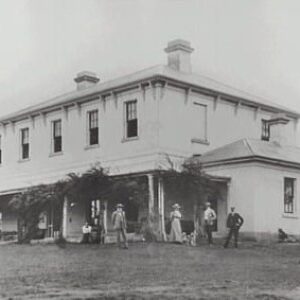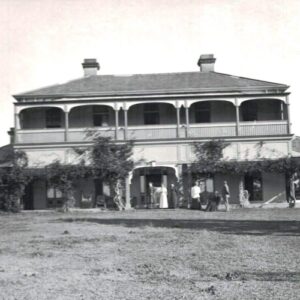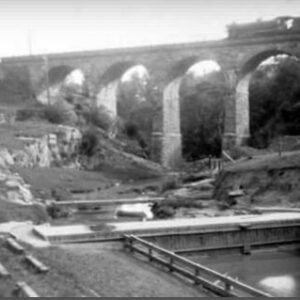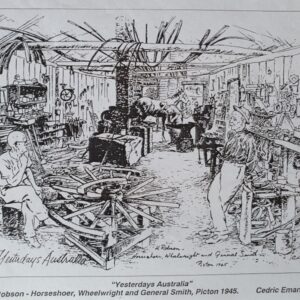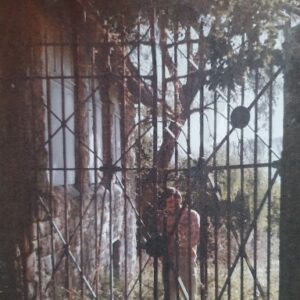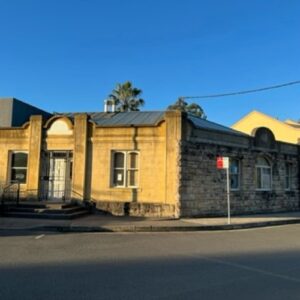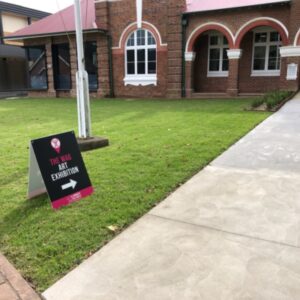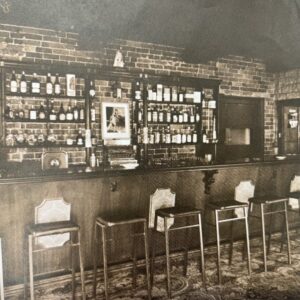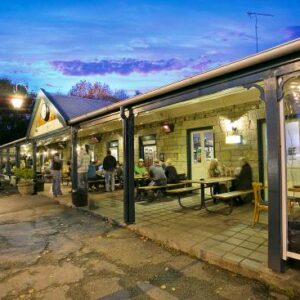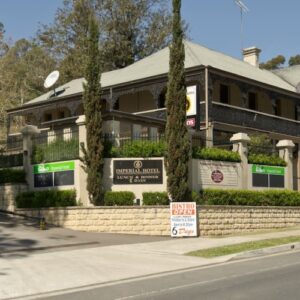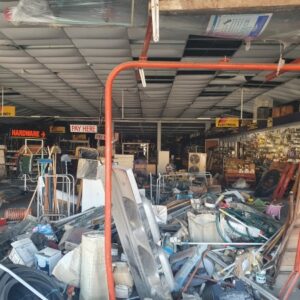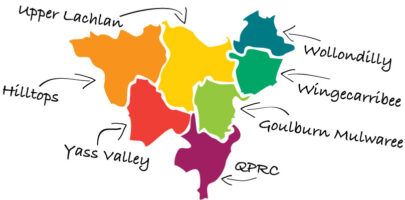Picton is a place of many tales. The stories have been gathered below from the community. These reflect the rich and complex history of Picton. The memories we hold and the stories passed down through families. It’s a vibrant place full of heritage and living history.
200 Bargo Tahmoor Picton is possible because for the generous contribution of Picton and District Historical and Family Society Inc., The Wollondilly Heritage Museum and Historians Marjo Hallowell and Marlane Fairfax.
Picton, first known as Stonequarry was the earliest township when the established of the Jarvisfield Estate created the private town of Picton in 1841. The towns of Bargo and Tahmoor took much longer and although white settlement for both dates from 1822, it was not until 1919 when the railway deviation was built and passed through the localities that these towns flourished.
Jarvisfield
2 km north of town of Picton is the impressive Victorian stuccoed brick country house Jarvisfield (1865), now the Antill Park Golf Club.
John Macquarie Antill commissioned colonial architect William Weaver to build Jarvisfield in the “Victorian Regency style’’ in 1863.
The estate was part of an original land grant to John’s father, Major Henry Colden Antill would was award 3000 acres by Governor Lachlan Macquarie. This was subdivided in 1844 and Picton was created – the first private town in the colony.
Jarvisfield was named after Jane Jarvis, the first wife of Governor Lachlan Macquarie who died in Bombay when she was just 23 in 1796.
The estate was in Antill family hands until 1974, when Wollondilly Shire Council became the owner of both the Jarvisfield homestead and the land around it.
In recent times the heritage listed house has become part of the Antill Park Golf Club and the name Jarvisfield has been applied to a new development.
Do you have a story about Javisfeild or the Golf Club? We’d love to share it on this page. Share your story NOW
Railway Viaduct
Access via the end of Webster St. The Viaduct is a heritage-listed railway over Stonequarry Creek in Picton. The sandstone structure was designed by John Whitton as the Engineer-in-Chief for Railways and was built from 1863 to 1867 by Murnin and Brown. It is also known as Stonequarry Creek Railway Viaduct.
The viaduct crosses Stonequarry Creek and consists of five 12.2 metre arches made of stone quarried 200m downstream. It is 84.1 metres in length, is 23.8 metres at its highest point, and is the oldest stone archway over water still in use in New South Wales. It has been in continuous use since it was opened in 1863. Modifications haven’t been necessary to the craftsmanship and today it stands in original condition. During its construction two workers lost their lives. It represents a major technological achievement in the construction of the Great Southern Railway line by John Whitton.
In the 1930s the decision was made by Picton Progress Association to build a swimming pool down from the viaduct. The pool was officially opened on 17 February 1934 and was seven feet (over 2 metres) at the deepest point. Within two weeks of the opening floods caused damage however everything was put right for the Back to Picton weekend in April 1934. Four years later the Progress Association asked council to assume control of the pool which they eventually did however the pool was often closed due to health risks and was closed permanently in March 1940.
Wollondilly Council and Picton Blacksmiths
62 Menangle Street. On the site of the current Wollondilly Council Building until 1947 was H. Robson Horseshoer, Wheelwright and General Smith Picton 1945. In the drawing by Cedric Emanuel you can see Harry Robson, blacksmith and wheelwright, sits on the left while Bill Barnes, his stepson, is with the
horse. Bill Hoff, a carter with draught horses, stands to the side. There was a blacksmith’s shop in Menangle Street Picton for some 80 years until resumed by the Wollondilly Council’s Electricity Department in 1947. Today the Council Administration building occupies the site.
Harry Robson gave the shop to his stepson Bill Barnes, a returned soldier, who worked in Menangle Street until moving to a shed behind his home in Campbell Street. He closed down shortly after and with the exception of a few pieces of equipment being saved as souvenirs, the rest was melted as scrap metal. One item that was saved was the hand-cut cooling trough in the centre of the picture. Wollondilly Shire Council has kindly lent this trough to Wollondilly Heritage Centre to display in this replica blacksmith’s shop. Information compiled by Betty Villy of the Wollondilly Heritage Centre
Kutnewsky Feather & Fur factory now Vaby’s Restaurant
2 Station Street Picton. Built in 1920c by Wilhelm Kutnewsky, the Feathers& Fur factory made tippets, boas and feathered cockades for the slouch hats of Army Mounted Lancers.
The building includes iron gates bearing the initials “HMC” (Her Majesty’s Customs) the gates are dated 1886 and came originally from Customs House in Sydney.
The building was for a time (c1932-1940) used for Cheese manufacturing and was damaged by fire in c1959 after which it lay idle for years in a derelict state. Restored in the 1990’s by John Corbett a local businessman, it is now referred to as “The Old Cheese Factory” and operates as Vaby’s Restaurant opening in 2000.
Wollondilly Shire Hall
Councillor Suzy Brandstater has lived and worked in Wollondilly for 33 years. She has taught many of the Shire’s children during her time as a teacher at Picton High School. Suzy is a STA Delegate as part of her duties at Council and a strong advocate for the Arts.
The George IV Inn
“The George” Located at 180 Argyle Street is one of the oldest standing buildings in Picton. Said to have been built in 1819 but not licensed until 1839 it is a rambling, single storey building on the southern side of Stonecutter Creek. The inn’s veranda, stables and courtyard capture an earlier time when the journey from Sydney was a long and uncomfortable coach ride. Since 1987 there has been an independent brewery, Scharer’s Little Brewery, which is known for its Burragorang Bock and Scharer’s Lager.
Liz Vincent writes in her book ‘Historic Picton: A walk through Picton’s Past’ that “early records indicated that the ‘George’ was built in late 1839.” It was originally a building of 21 rooms, including sitting rooms and bedrooms. There was also a stone stable, horse stalls and adjacent paddocks and stock yards. The George still stands as a well known pub, and has been lovingly restored after devastating flooding in 2016. An unexpected upside to the massive renovation effort at the much-loved pub – the discovery of several historic artefacts and, most startling of all, a convict hold.
Like many buildings of it’s age rumour has it that the George is haunted as this Ghost Chasers video explores. For more information check out The George IV website.
The Imperial Hotel
196 Menangle St, Picton. The Terminus Hotel was built 1861 and was later known as The Club Hotel before taking on the name of the Imperial Hotel which still remains. Today the building and surround gardens are slowly degrading since being closed permanently in 2014.
Both the station area and the Private Town were part of the original grant of Jarvisfield to Major Henry Antill in 1822, with Stonequarry Creek its southern border. A wonderful view of the station area, including the Stonequarry Viaduct and parts of Campbell and Webster Streets –The photo was taken around 1910. Interest in this area started before the railway line was opened, with the then Terminus Hotel (Imperial) being opened in 1861. The hotel ceased trading for a time in the 1880s and the building used as a hospital for tuberculosis patients. The hospital was called Florence Villa run by John Goodlet who later built what was to become Queen Victoria Memorial Hospital. The hotel was re-licensed as “The Club” the name changing to “The Imperial” in the 1930s.
Do you have a fun story of a night at the Imperial? We’d love to share it on this page. Share your story NOW
K & V Corbett Hardware
Located at 36 Menangle Street Picton. Operate by owners Keith and Valerie Corbett until April 2010 when Keith passed away. Today the aging remains of the store can still be seen. It bears the mark of being locked up but preserved complete with aging stock and decaying features. The decay being accelerated by inundation from flood waters in 2016.
In 2012 the store was used as a set for the film Wolverine and rebranded to be Faro Hardware (based on an actual hardware store in the Yukon Canada). Today the remains of that signage can still be seen as the site continues to decay.
In 2018 Keith and Valerie’s son, John Corbett planned to redevelop the site to include a 34-room motel, micro-brewery, restaurant, function centre and retail shops. However, the plans never eventuated after John died while piloting a light aircraft that crashed near Braidwood.
Today it’s a remarkable window into a bygone era of Picton’s past and well worth a visit to marvel at the interior through the front window. It’s an eerily and strange experience to peer into a place preserved in time in the heart of downtown Picton.
This is a hardware store like no other, it is quite large and whatever you need it will be in this store. Mr Corbett who owns the store can tell you where everything is. They have a variety of homewares as well. Customer review from 2008
A Little Bit of history
Picton was opened up to colonial settlers from 1821. Before this time it was beyond the limits of legal settlement. This followed the building of the new Great South Road between Sydney and the Southern Highlands in 1819 which cut over the Razorback Range from Camden.
It was first know as Stonequarry and was renamed Picton in 1845.
Picton remained a stopping point on the Great South Road, which become the Hume Highway, until it was bypassed in 1980. The railway arrived in Picton in 1863.
“With the coming of the railway the area around the station developed into the “third town of Picton”, after Antill’s Private Town of Picton (or Lower Picton), and Upper Picton – a town established by the government. Both the station area and the Private Town were part of the original grant of Jarvisfield to Major Henry Antill in 1822, with Stonequarry Creek its southern border. ” (Picton and District Historical and Family Society Inc)
Picton is home to many historic buildings including those that developed around the Railway precinct. It is also home to two significant bridges.
Images and Text below for Picton supplied by Picton and District Historical and Family Society Inc unless otherwise credited.
Wollondilly Shire is on Aboriginal land and the country of the Dharawal and Gundungurra peoples. While celebrating the bicentenary of Bargo, Picton and Tahmoor since European settlement we acknowledge their traditional custodianship and culture over countless generations. The deep connection of Aboriginal people to this country continues a rich traditional of culture and custodianship. May we all walk forward together into the future.
Picton Parish Maps This series of images shows some of the progression of the development of Picton town, showing early road alignments and subdivision estate plans. USe the google map to visit the place and spaces from the stories above.
![]()
200 Bargo Tahmoor Picton is a Wollondilly Shire Council project delivered by STA and possible because for the generous contribution of Picton and District Historical and Family Society Inc., The Wollondilly Heritage Museum and Historians Marjo Hallowell and Marlane Fairfax.
STA MEMBERSHIP
free & connects you to the STA universe
Reach out to us
[email protected]
0427 938 110
Or by appointment at one of our
Mobile Office locations
PO Box 1323 Goulburn 2580
ABN 67 208 214 681
We acknowledge Aboriginal people as the traditional custodians of the lands where we create, live & work.
© Southern Tablelands Arts. All Rights Reserved


